Non-native and Native Yard Trees of Mississippi
Non-native, invasive plants can spread quickly and replace native plants, negatively impacting air quality, wildlife, and the economy. To support a healthy urban ecosystem, we want to remove invasive, non-native species and promote native tree species. Here, you will find five common invasive, non-native tree species and five native species that you should use instead.
Species to Avoid
Callery (Bradford) pear (Pyrus calleryana)
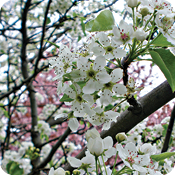
- Introduced from China in 1916.
- White flowers smell like fish.
- Weak wood susceptible to cracks, branch breakage, and stem splitting during storms.
- Birds eat hard fruits and spread seed, which take over open areas and compete with native plant species.
Chinese tallow tree (Triadica sebifera)
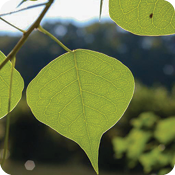
- Introduced from China in the 1770s; established in the early 1900s.
- Planted for seed oil and soap.
- Seed pods resemble popcorn (a common name is “popcorn tree”).
- Leaves and fruit are toxic to cattle and humans.
Mimosa (Albizia julibrissin)
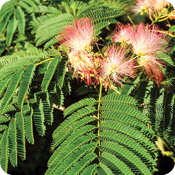
- Introduced from the Middle East/Asia in the 1700s.
- Delicate pink blooms attract pollinators, but seed pods are toxic to dogs.
- Seeds spread via water/wind.
- Aggressively outcompetes native plants important for native pollinators.
Tree-of-heaven (Ailanthus altissima)
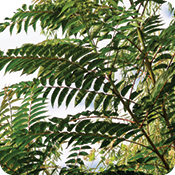
- Introduced from Asia in the 1780s.
- Crushed leaves and twigs smell like burnt peanut butter or cat urine.
- Spreads through root sprouts and produces many wind-borne seeds (300,000+ per year).
- Produces toxins that suppress other plants.
Chinaberry (Melia azedarach)
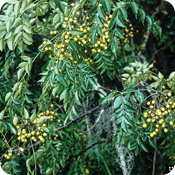
- Introduced from Asia around 1830.
- Purple flowers do not attract insects or hummingbirds.
- Entire plant is toxic to humans, cats, and dogs.
- Produces root sprouts and toxins that allow it to outcompete native plants and quickly take over an area.
Species to Use
Downy serviceberry (Amelanchier arborea)
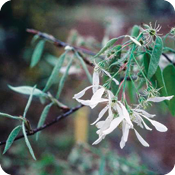
- Known as the “four-seasons tree,” with white flowers in spring, red berries in summer, red-orange leaves in fall, and light gray bark in winter.
- Supports songbirds and mammals.
- Grows up to 25 feet tall and prefers full to partial sun.
Eastern redbud (Cercis canadensis)
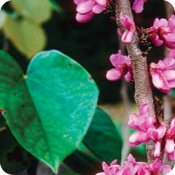
- Heart-shaped leaves provide shade.
- Pink-purple flowers are very showy in spring and support pollinators; leaves are used by leafcutter bees.
- Grows up to 30 feet and prefers partial shade and moist soils; tolerates full sun.
Common buttonbush (Cephalanthus occidentalis)
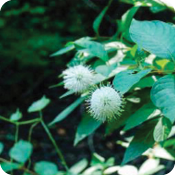
- Shrub or small tree (grows up to 15 feet) produces white-pink flowers that are aromatic and look like pincushions.
- Large, green, glossy leaves.
- Supports pollinators and birds.
- Grows well on moist sites with poor drainage.
- Prefers partial shade.
Honey locust (Gleditsia triacanthos)
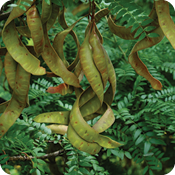
- Produces feathery leaves that turn yellow in fall and long, maroon pods with a sweet pulp.
- Grows up to 75 feet tall.
- Wildlife enjoy eating the pods and leaves.
- Prefers shaded, moist sites.
- Be sure to get a thornless variety; thorns can be 3–4 inches long.
Red maple (Acer rubrum)
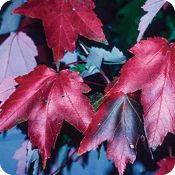
- Trident-shaped leaves turn a brilliant red in fall.
- Fruit (samaras) and tender foliage support squirrels, rabbits, and deer.
- Grows fast (up to 90 feet); tolerates shade and sun and a wide range of soils.
- Can be tapped for maple syrup.
How do I remove an invasive tree from my yard?
Most invasive species require cutting and applying herbicide to the stump. It may take several applications to successfully control them. For assistance with invasive species management, contact a local ISA Certified Arborist and/or tree surgeon in your area who has expert knowledge about tree removal and herbicide applications.
Where can I purchase native tree species to put in my yard?
Many nurseries around the state offer native plants. The Mississippi Native Plant Society maintains a list of nurseries that sell native plants. The second week of February is Mississippi’s Arbor Day celebration, and many counties give trees away during that week. Please see the Mississippi Forestry Commission website for more information.
Funding was provided by the Mississippi Forestry Commission Urban and Community Forestry Grant Program, Grant Award 21-DG-11083128-001 to the Mississippi State University Department of Forestry.
Publication 4025 (07-24)
By Ashley Schulz, PhD, Assistant Professor, Joshua J. Granger, PhD, Assistant Professor, A. Brady Self, PhD, Associate Extension Professor, and Drew Williams, PhD Student, Forestry.
The Mississippi State University Extension Service is working to ensure all web content is accessible to all users. If you need assistance accessing any of our content, please email the webteam or call 662-325-2262.


